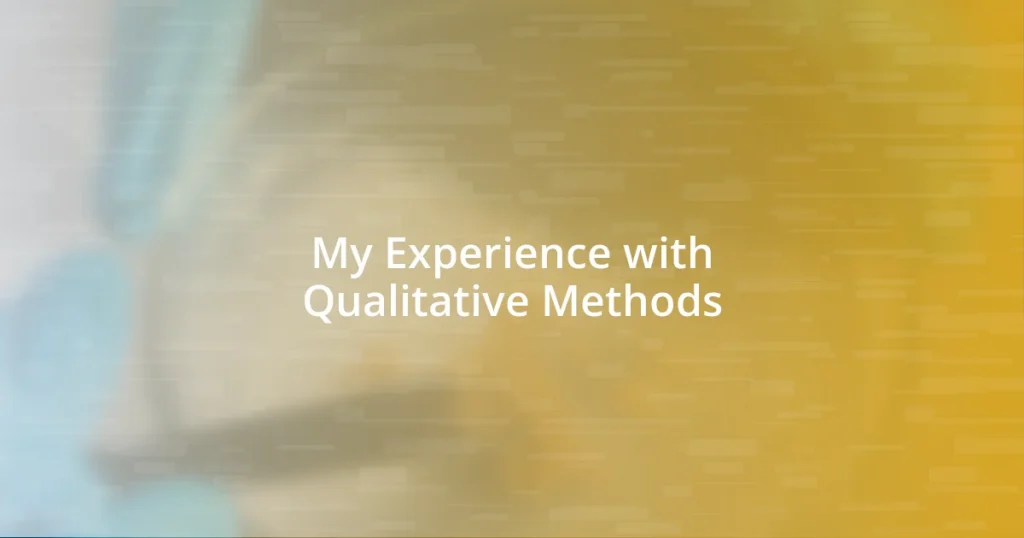Key takeaways:
- Qualitative methods offer rich insights into human experiences, allowing researchers to uncover nuances and connect on a personal level with participants.
- Flexibility in conversations can lead to unexpected revelations, enhancing the quality of data collected and deepening the understanding of participants’ narratives.
- Analyzing qualitative data involves careful coding and interpretation, sometimes revealing themes and insights that challenge initial perspectives and highlight the importance of patience and reflection.

Understanding qualitative methods
Qualitative methods are all about exploring the depths of human experience. I remember my first qualitative study where I interviewed participants about their coping strategies during a crisis. Their stories were rich and nuanced, revealing layers of meaning that numbers alone could never capture. Isn’t it fascinating how a simple conversation can unlock so much understanding about people’s lives?
What strikes me the most is the flexibility of qualitative methods. Unlike quantitative approaches that confine us to predetermined answers, qualitative methods invite us to follow the flow of conversation. There was a moment when a participant veered off-script and shared a heart-wrenching memory. That spontaneous insight added a depth to my analysis that I hadn’t anticipated. Have you ever had a moment where you learned something profoundly meaningful just by letting a discussion unfold naturally?
In my experience, qualitative methods shine in their ability to connect with participants on a personal level. I often find that creating a safe space for sharing can lead to unexpected revelations. During one focus group, topics shifted from initial questions to gut-wrenching personal stories that left all of us teary-eyed. It made me realize that behind every data point, there’s a human story waiting to be told. How often do we really take the time to listen?

Importance of qualitative research
Qualitative research holds immense importance in understanding the complexities of human behavior and experiences. From my perspective, it opens doors to the intricate narratives that shape people’s thoughts and actions. For example, during a project exploring mental health, I discovered that quantitative surveys could never truly capture how stigma affected individuals’ willingness to seek help. Hearing firsthand accounts added emotional weight and context to the data that statistics simply couldn’t provide.
Here are a few reasons why qualitative research is vital:
- Rich Insights: It captures the nuances of human experiences.
- Flexibility: Researchers can adapt questions based on participant responses, digging deeper into unexpected themes.
- Empathy: It fosters a stronger emotional connection between the researcher and participants, leading to more authentic data.
- Cultural Understanding: It allows for the exploration of social and cultural contexts that influence behaviors and beliefs.
Through these layers of understanding, qualitative research navigates the intricate fabric of human life, revealing stories that resonate on an emotional level.

Types of qualitative research methods
When discussing the types of qualitative research methods, I often reflect on interviews and focus groups, both of which have their unique charms. Interviews, for instance, allow for deep one-on-one engagement, where the participant may feel more comfortable sharing intimate thoughts. I recall an interview with an elderly gentleman who recounted his experiences during World War II. His voice trembled as he spoke of loss and friendship, and I found myself captured by the depth of emotion he portrayed. This method not only offers a structured approach but also nurtures a genuine connection between the researcher and the participant.
On the other hand, focus groups bring the dynamic energy of group discussions to the table. In my experience, the interaction among participants often sparks memories or anecdotes that might not surface in individual interviews. I remember facilitating a focus group with university students discussing their educational challenges. As different voices chimed in, the collective frustration and humor created a lively atmosphere. That interplay allowed me to gather diverse perspectives in a way that felt vibrant and dynamic—a contrast to the quieter introspection of individual interviews.
Lastly, there are observation techniques, which can be incredibly eye-opening. I once participated in a study where my task was to observe children in a playground setting. Initially, I thought it would be straightforward, but I was surprised by the intricate social dynamics at play. Watching the kids interact, I witnessed bullying, camaraderie, and problem-solving firsthand. This observational method enables researchers to capture behaviors in their natural environments, revealing layers of context that words sometimes fail to express.
| Research Method | Description |
|---|---|
| Interviews | One-on-one conversations that provide deep insights into individual experiences. |
| Focus Groups | Group discussions that encourage interaction and generate diverse viewpoints. |
| Observation | Careful watching of participants in their natural settings, allowing for contextual understanding. |

Implementing qualitative methods effectively
Implementing qualitative methods effectively hinges on creating a comfortable environment for participants. I remember a project where I focused on sensitive topics like grief. To set the tone, I chose a cozy café instead of a sterile office. This setting encouraged openness; participants felt relaxed enough to share stories they’d kept private for years. Isn’t it fascinating how the right atmosphere can unlock deep emotions?
In my experience, active listening is crucial during data collection. I recall one participant who began to mention a traumatic event but hesitated. By giving her the space to breathe and processing my own thoughts carefully, I simply nodded and encouraged her to continue. That moment of silence allowed her to find her voice, resulting in insights that were not only valuable but deeply moving. How often do we overlook the power of patience in these settings?
Another key aspect is the iterative process of analysis. Often, I’ve felt the urge to dive into the data right after collection. However, stepping back and revisiting recordings or notes days later led me to unearth patterns that weren’t apparent initially. For instance, while analyzing interviews on workplace dynamics, I discovered recurring themes around microaggressions that took time to surface. Has this happened to you, where a second glance reveals a richer narrative than the first? Embracing this gradual approach can truly enhance the depth of qualitative findings.

Analyzing qualitative data
Analyzing qualitative data can feel like piecing together a puzzle, and I’ve found that coding is often the first and most illuminating step in this process. During my own analyses, I would meticulously go through transcripts, assigning labels to segments of text that resonated with key themes. It’s amazing how these codes provide a scaffold for understanding—transforming raw data into a coherent narrative. Have you ever felt the thrill of uncovering a theme that shifts your entire perspective on the data?
One time, while analyzing a series of interviews focused on family dynamics, I stumbled upon an underlying theme of resilience. Initially, I was just looking for common challenges, but as I coded, these stories of overcoming adversity began to shine through. This made me rethink how I approached the interpretation. Rather than merely summarizing experiences, I aimed to narrate the triumphs that highlighted each individual’s journey. It’s intriguing how sometimes, the data leads you to insights you never anticipated.
Moreover, visualizing data can significantly enhance comprehension. Creating charts or thematic maps allowed me to see relationships among concepts at a glance, almost like turning a complex melody into a simple tune. In one project, I used color-coded notes on a board to represent different emotional responses I encountered in interviews. Walking past that visual display felt like revisiting a vibrant gallery, where each color told its own story. Have you explored the power of visuals in your analyses? It can elevate your understanding and communicate your findings with a captivating clarity.

Challenges in qualitative research
One significant challenge I’ve encountered in qualitative research is managing researcher bias. I recall a project where I was deeply invested in the topic of mental health. It became apparent that my own experiences were inadvertently shaping my interpretation of participants’ stories. To combat this, I engaged in reflexive journaling, regularly reflecting on my thoughts and feelings. Have any of you struggled with separating your personal biases from your analysis? Recognizing this as an ongoing process can lead to richer, more authentic insights.
Another hurdle is the subjectivity of data interpretation. I once analyzed focus group discussions about community perceptions of public spaces. Different participants highlighted contrasting ideas about safety and accessibility, which created a whirlwind of opinions to parse through. I had to remind myself that each narrative held equal weight, even when they contradicted each other. Isn’t it a challenge to embrace ambiguity? Working through these layers often brings deeper understanding, but it demands a willingness to accept that there may not be a singular “truth” in qualitative research.
Time constraints can also pose significant obstacles. In one instance, I was tasked with analyzing interview data for a fast-approaching deadline. Rushing through the coding process led me to overlook nuanced expressions and emotional undertones that were vital to the narrative. I learned the hard way that taking the time to immerse myself in the data truly enriches the findings, even if deadlines loom. Has anyone else felt the pressure to compromise depth for speed? Balancing these demands remains a constant struggle, yet it’s critical for maintaining the integrity of qualitative insights.

Lessons learned from qualitative methods
I realized early on that qualitative methods really emphasize the importance of listening. During my research, I took part in a conversation with a participant who shared their family’s story about navigating cancer treatment. I thought I understood their experience, but it wasn’t until I listened intently that I grasped the depth of their emotions—fear, hope, and immense strength. Have you ever had a moment where listening transformed your understanding? This reminded me that sometimes, the most profound lessons come not from asking questions but from absorbing the answers fully.
Another lesson that stands out is the value of flexibility. While I planned my interviews with a set list of questions, I learned to follow the conversation where it naturally flowed. One particular session took an unexpected turn when a participant began to recount childhood memories unrelated to the topic. At first, I hesitated, fearing I was veering off course, but that’s where I found the most genuine insights. Isn’t it fascinating how staying open can lead you to overlooked narratives? Embracing this spontaneity not only enriched my data but also deepened my rapport with participants.
Lastly, I came to appreciate the power of narratives in qualitative research. I once had the privilege of compiling stories from individuals who had experienced homelessness. As I wove their testimonies together, I realized that these narratives had the potential to challenge societal perceptions. Each story illuminated not just the struggles but also the humanity behind their experiences. Isn’t it remarkable how a single narrative can shift perspectives? This taught me that qualitative methods are not just about gathering data—they are a means to amplify voices that often go unheard.















